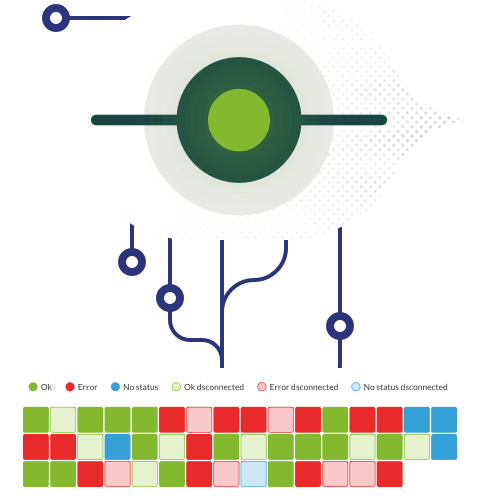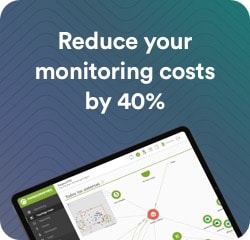Introduction
We are all living digital experiences both within an organization and in every physical and digital transaction we make outside of it. Digital Experience (DX) refers to the one in which users interact with digital platforms, services, or products, whether from a website, mobile apps, social media, or digital marketing. For customers, digital experience (online shopping, chatbot support, apps connecting to services, etc.) impacts their satisfaction, brand loyalty, and therefore, a company’s financial results. Of course, a poor experience will have a negative impact on the organization’s revenue and reputation. According to ComputerWeekly, DX also refers to elements such as the navigability and performance of a website, and the efficiency with which users can complete actions (number of clicks or swipes) or whether an app or page is properly integrated with others.
This clearly shows that there is a relationship between the customer’s digital experience and web monitoring to understand and improve how users interact with the organization’s websites and applications.
Why Digital Experience is Key in IT
Digital experience is the one that is reflected in an end user after an experience in a digital environment or with a digital technology or device. Most of the times, Digital Experience (DX) and Digital Customer Experience (DCX) can mean the same thing, but there are differences that we can explain better in the following table:
Differences Between Digital Experience and Digital Customer Experience
|
Digital Experience |
Digital Customer Experience |
|
|
Definition and Goal |
It refers to the interaction of any user with a digital platform (a website, a mobile app, or any digital channel). Its goal is to optimize operability and usability. |
It refers to the experience of customers with the company through its digital channels. Its goal is to improve the customer experience and their loyalty through digital interactions. |
|
Approach |
Technical and design aspects that affect how a digital platform is perceived and used, such as usability, interface design, load speed, and operability. |
The way digital interactions are carried out and how they impact the customer’s perception of the brand and their satisfaction, including ease of use, customization, online customer support, and consistency across each digital interaction. |
|
Users |
Employees, partners, and any other users who interact with the organization’s digital platform. |
Current and potential customers seeking to improve their satisfaction and loyalty to the brand. |
Since the pandemic, the digital transformation of organizations has accelerated to such an extent that we can claim that all internal and external customers are now digital. As a result, digital experience is no longer a competitive advantage but has become a standard for any digital organization, to the point where there is already the ISO 25010 standard (ISO, n.d.) to guarantee security and trust along with efficient and effective service for customer needs, with over 25 measurable scales covering aspects such as operability, reliability, usability, efficiency, software maintainability, portability, and overall visible quality.
Impact on IT Infrastructure Management and Web Performance
The user digital experience has led organizations to undertake better management of IT infrastructure, requiring scaling the hardware and software that support IT services and resources, in addition to improving security monitoring to protect data and systems. In terms of web performance, the digital experience has made speed or load time necessary (e.g., to reduce abandonment or bounce rates), optimization of resources connecting from mobile devices, as well as improvements in frictionless user interactions, and enhancing search engine performance and network traffic. In other words, awareness of the user-centered experience has been created, and it is now necessary to implement digital experience monitoring using methods, platforms, and tools to see, measure, and improve user interaction with digital platforms (websites and apps).
Web Monitoring and Digital Experience
Previously, websites had static content; today, content is highly dynamic. Both WordPress (used in more than 40% of the world’s blogs) and HTML code (with the advantage of storing information in databases) are used, which makes web monitoring more complex.
What is web monitoring, and how can it improve DX?
Web monitoring involves checking the availability and performance of a website, considering uptime or downtime, response times, load times, and other factors. This monitoring improves the digital experience (DX) as it allows for identifying website performance (through key performance indicators or KPIs) and potential or existing issues. From this information, the goal is to optimize the operation of digital platforms to ensure seamless and satisfactory user experience.
Key KPIs to Measure Digital Experience
In web monitoring, there are multiple KPIs that you and your team may define in your monitoring platform, such as:
- Core Web Vitals (LCP, FID, CLS):These are metrics developed by Google to measure key aspects of user experience on a webpage:
- LCP (Largest Contentful Paint) – It measures loading performance. For a good user experience, an LCP should take place within the first 2.5 seconds from the moment the page begins to load.
- FID (First Input Delay) – It measures interactivity, from when a user first interacts with a page (e.g., clicking a button) to when the browser responds to that interaction. An FID of 100 milliseconds or less is recommended.
- CLS (Cumulative Layout Shift) – It measures the unexpected movement of content on a page while it is loading. A low CLS indicates that the page is visually stable. A CLS of less than 0.1 is recommended.
- Bounce Rate and Page Load Time: The bounce rate is the percentage of visitors who leave a website after viewing only one page without interacting with it. Page load time refers to the average time it takes for a webpage to fully load on the user’s screen, from the moment a link is clicked to when all elements are loaded. It is recommended for this time be no more than 3 seconds to prevent user abandonment or frustration.
- Website Availability and Uptime: Website availability relates to the ability of a site to be accessible and operational for users, ensuring that the domain, web hosting, and DNS settings are properly configured and functioning. Uptime refers to the time during which the website is operational and accessible without interruptions. Ideally, uptime should reach 99.99%.
- Web Performance Alerts and UX Errors: Web performance alerts are automated notifications that trigger when performance parameters (such as page load time or site availability) exceed predefined thresholds. For example, alerts for 500 or 404 errors (server unavailable). UX errors can include confusing navigation or unclear error messages, which can result in lost conversions (a potential customer becomes frustrated with a page that will not load).
It is also recommended to rely on web content accessibility guidelines, such as the Web Content Accessibility Guidelines (WCAG), published by W3.org which include features that influence the digital experience, such as perceptibility, operability, understandability, robustness, and compliance.
Tools to Improve Digital Experience
Now that we understand what can be monitored to improve the digital experience, we recommend relying on the following:
- Web Monitoring and Observability Platforms: You should rely on robust web monitoring platforms that allow you to implement effective observability across four key pillars: metrics, events, logs, and traces; in other words, MELT, to understand the internal state of the system based on its external results.
- Use of AI and Predictive Analytics for UX Optimization: With a monitoring platform capable of integrating predictive analytics, you can use data and statistical models to anticipate future user needs and actions, improving the user experience (UX). Additionally, a strong monitoring platform can integrate advanced technologies like Artificial Intelligence (AI) for deeper analysis and pattern identification, allowing you to personalize the experience in real-time, thus enhancing user relevance and satisfaction.
- Integration with DXP (Digital Experience Platforms) and DEM (Digital Experience Monitoring): DEM involves monitoring and analyzing the performance of digital applications and services from the end user’s perspective, while DXP is a set of technologies used to create, manage, deliver, and optimize custom digital experiences across multiple channels in the customer journey. DXP can include content management platforms, customer data management, analytics and marketing automation, omnichannel support, eCommerce, and AI-driven personalization. DXPs use DEM to monitor and optimize the user experience, ensuring their digital interactions are satisfactory.
As you may see, the integration of open technologies and platforms that may communicate with each other allows for the enhancement of capabilities to focus on digital experience.
Advantages of Applying a Digital Experience Strategy in IT
The main advantage of implementing a strategy focused on digital experience is the optimization of that experience, where users interact with solid, intuitive, and easy-to-use platforms, which in turn increases their satisfaction, loyalty to the brand, and the organization. Additionally, the following benefits can be achieved:
- Improve Customer Retention and Reduce Churn: Satisfaction with the digital experience reduces churn or cancellation rate (when a user stops using a product or service) and also leads to a higher conversion rate (from a prospect to an active customer) and customer retention, establishing long-term relationships.
- Optimize Web Performance and Response Times: Proper digital experience monitoring platforms provide real-time data and analysis to identify website performance and pinpoint areas for improvement, allowing response times to be optimized and, consequently, improving the user experience.
- Reduce IT Infrastructure Costs: Constant and real-time monitoring of networks and systems also leads to greater efficiency and cost reduction in IT infrastructure by helping identify inefficiencies and adjust resource consumption in real-time. It also allows for process automation, reducing manual and repetitive tasks.
- Implement Digital Security and Prevent Failures in Multicloud Environments (SIEM): Leveraging advanced technologies like SIEM (Security Information and Event Management) enables you to identify, monitor, log, and analyze (addition and correlation of data) security incidents within an IT environment in real-time, providing a comprehensive and centralized view of the entire IT security landscape (on-premise, hybrid, Edge Computing, and multicloud). Another key aspect of SIEM is the ability to enforce regulatory compliance in security. This undoubtedly enhances users’ digital trust.
Web Monitoring and Digital Experience Improvement with Pandora FMS
Pandora FMS allows you to implement digital experience monitoring, as it has the capabilities to detect and analyze issues that affect or may impact the user at any point in your technology stack (applications, networks, and backend). With this platform, you and your team can:
- Gain Full Visibility: Reduce response times and ensure a 100% service level (SLA).
- Improve Performance: Identify key performance metrics for page load, user interactions, and element downloads. Detect bottlenecks and latency issues by implementing website monitoring.
- Integrate User Experience Monitoring with Other System and Network Monitoring: Integrate data into reports and real-time alerts.
- Create User Experience Tests: Use a recorder to run tests without coding, as well as launch different tests from different geographic locations.
Pandora FMS also enables synthetic transaction monitoring (under a scripted scenario to replicate real user behaviors) from the same platform used for standard monitoring. This allows you to establish correlations between the data obtained from synthetic transactions and other monitoring, keeping all metrics in one central location to efficiently identify potential problems.
Integration with Observability and Telemetry Tools
Pandora FMS offers advanced capabilities in observability, monitoring, security, and IT service management, all within a unified platform tailored to your business needs, in on-premise, hybrid, or cloud environments. Its telemety capabilities allow data collection from physical devices, agents, and software-based modules.
Real Use Cases: Improving DX (Digital Experience)
- More Customized Workspaces: By monitoring the digital workspace environment, including network performance and application availability, insights can be gained into performance and latency improvements, ensuring the user experience is based on their specific needs.
- Continuity and Optimized Environments: Monitoring applications and resources in hybrid and multicloud environments (which are becoming more common) allows for visibility and management of IT resource and service performance, ensuring business continuity and allocating resources based on service demand and network traffic. It also helps reduce costs associated with underutilized assets.
Conclusion
In this digital era, improving user satisfaction and maintaining competitiveness in the market depends on implementing a Digital Experience (DX) strategy supported by comprehensive IT monitoring that provides you with all the elements needed to collect data from your infrastructure, networks, and IT services, to analyze and contextualize it intuitively. You will need to rely on open and integrated IT monitoring platforms and tools like Pandora FMS, with solid capabilities to implement digital experience. Reach out to our experts at Pandora FMS who can assist you with any monitoring challenges.
Pandora ITSM is a balance between flexibility, simplicity and power
And above all, it adapts to your needs.









